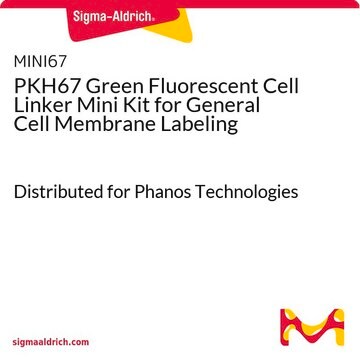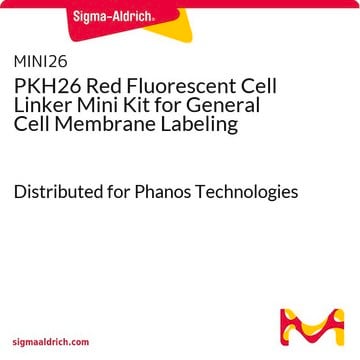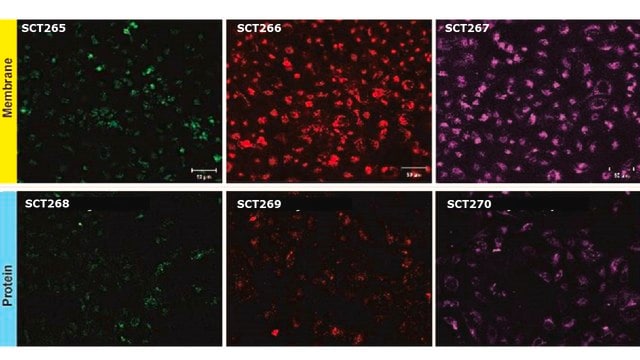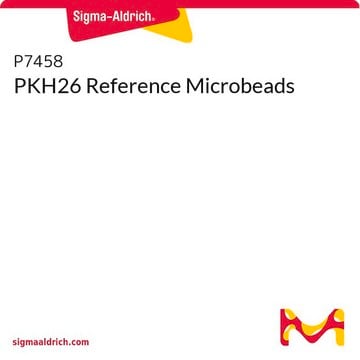The PKH dyes have a long aliphatic tail that inserts into the membrane, with PKH26 > PKH67 > PKH2. The total numbers of carbons in the alkyl tails for PKH26 are greater than for PKH67, which are in turn greater than for PKH2. The exact tail structures are regarded as proprietary information.
Kluczowe dokumenty
MIDI67
PKH67 Green Fluorescent Cell Linker Midi Kit for General Cell Membrane Labeling
Distributed for Phanos Technologies
Synonim(y):
Zestaw do znakowania midi zielonej membrany PKH
Wybierz wielkość
2610,00 zł
Wybierz wielkość
About This Item
2610,00 zł
Polecane produkty
opakowanie
pkg of 1 kit
producent / nazwa handlowa
Distributed for Phanos Technologies
warunki przechowywania
protect from light
metody
flow cytometry: suitable
fluorescencja
λex 490 nm; λem 502 nm (PKH67 dye)
Zastosowanie
cell analysis
detection
metoda wykrywania
fluorometric
Warunki transportu
ambient
temp. przechowywania
room temp
Opis ogólny
Slow loss of fluorescence has been observed in in vivo studies using PKH1 and PKH2. PKH67 may exhibit similar properties since this behavior appears to be characteristic of green cell linker dyes, but not red cell linker dyes. Correlation of in vitro cell membrane retention with in vivo fluorescence half life in non-dividing cells predicts an in vivo fluorescence half life of 10-12 days for PKH67. Other green cell linker dyes with similar half lives have been used to monitor in vivo lymphocyte and macrophage trafficking over periods of 1-2 months, suggesting that PKH67 will also be useful for in vivo tracking studies of moderate length.
Zastosowanie
Powiązanie
Informacje prawne
Tylko elementy zestawu
- PKH67 Dye 2 x 0.1
- Diluent C 6 x 10
Hasło ostrzegawcze
Danger
Zwroty wskazujące rodzaj zagrożenia
Zwroty wskazujące środki ostrożności
Klasyfikacja zagrożeń
Eye Irrit. 2 - Flam. Liq. 2
Kod klasy składowania
3 - Flammable liquids
Temperatura zapłonu (°F)
57.2 °F - closed cup
Temperatura zapłonu (°C)
14 °C - closed cup
Wybierz jedną z najnowszych wersji:
Masz już ten produkt?
Dokumenty związane z niedawno zakupionymi produktami zostały zamieszczone w Bibliotece dokumentów.
Klienci oglądali również te produkty
Produkty
Optimal staining is a key component for studying tumorigenesis and progression. Learn useful tips and techniques for dye applications, including examples from recent studies.
PKH and CellVue® Fluorescent Cell Linker Kits provide fluorescent labeling of live cells over an extended period of time, with no apparent toxic effects.
-
What is the length of the aliphatic tail for the PKH dyes?
1 answer-
Helpful?
-
-
What is the meaning of the abbreviation PKH?
1 answer-
The patent with number 5,665,328, filed in 1992, lists Paul Karl Horan (PKH) as the main inventor.
Helpful?
-
Active Filters
Nasz zespół naukowców ma doświadczenie we wszystkich obszarach badań, w tym w naukach przyrodniczych, materiałoznawstwie, syntezie chemicznej, chromatografii, analityce i wielu innych dziedzinach.
Skontaktuj się z zespołem ds. pomocy technicznej














